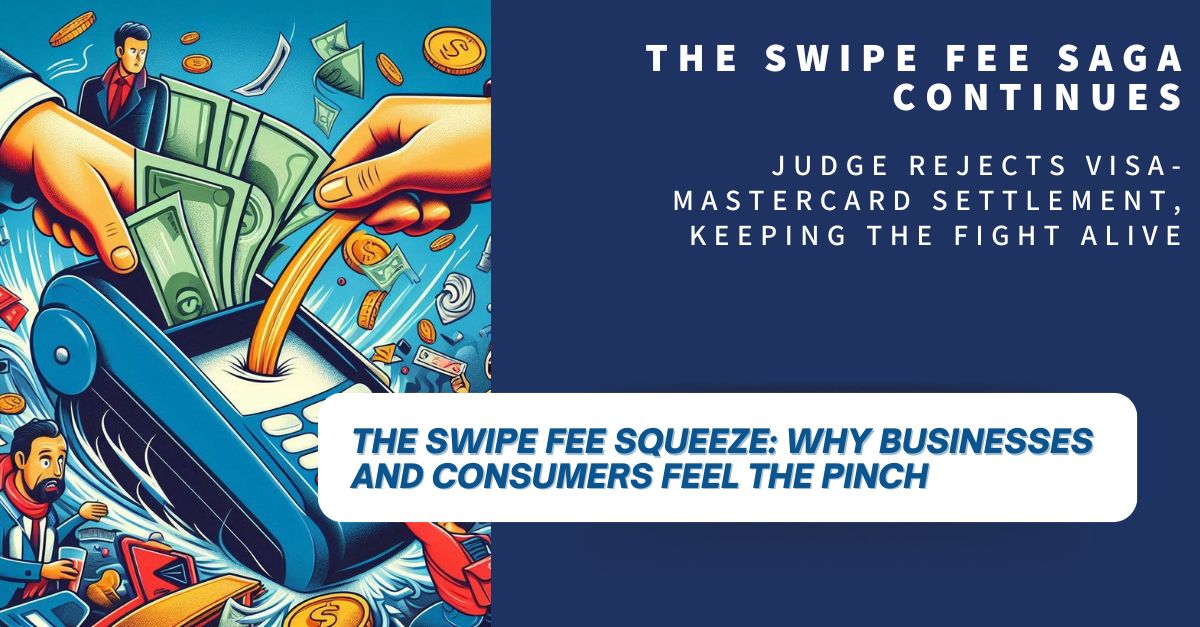
The Swipe Fee Squeeze: Why Businesses and Consumers Feel the Pinch
For businesses, the chime of a credit card purchase can be as welcome as it is bittersweet. While it signifies a sale, it also triggers a hidden cost: the dreaded swipe fee. These fees, paid to credit card companies and issuing banks for processing transactions, are a significant burden for businesses of all sizes. Let’s delve deeper into the world of swipe fees, their impact, and potential solutions.
A Growing Burden:
The Nilson Report paints a stark picture. In 2023, swipe fees on Visa and Mastercard transactions for American merchants ballooned to nearly $101 billion, a staggering $7.5 billion increase from just the previous year. This upward trend is concerning, squeezing profit margins for businesses and ultimately impacting consumers.
Who Gets Hit by Swipe Fee?

The impact of swipe fees is a double whammy. Here’s how it affects different stakeholders:
- Businesses: Swipe fees eat into their profits. While some businesses absorb the cost, many choose to pass it on to consumers in the form of higher prices.
- Consumers: Ultimately, the cost of swipe fees can be passed on to customers through increased product and service prices. This can strain household budgets and affect purchasing power.
Get cPanel hosting with 67% off!
Beyond the Cost:
The issue of swipe fees goes beyond just the financial burden. Here are some additional concerns:
- Limited Negotiation Power: Small and medium-sized businesses often have little bargaining power when it comes to negotiating swipe fees with credit card companies.
- Innovation Discouragement: High swipe fees can discourage businesses from adopting new payment technologies, hindering innovation in the payments landscape.
What Can Be Done?
Addressing the issue of swipe fees requires a multi-pronged approach:
- Regulation: Legislative efforts to cap or regulate swipe fees could provide relief for businesses.
- Alternative Payment Options: Encouraging the adoption of lower-fee payment methods like debit cards or mobile wallets can ease the reliance on credit cards and their associated fees.
- Merchant Negotiations: While challenging, businesses can explore negotiating lower swipe fees with credit card networks or processors, especially for high-volume transactions.
How do swipe fee impact online businesses?

Swipe fees, also known as interchange fees, are charges assessed by credit card processing companies on merchants every time a credit card is swiped for payment. These fees significantly impact online businesses in several ways:
- Operating Costs: Swipe fees are now typically retailers’ highest operating cost after labor. For online businesses, these costs can add up, affecting profit margins and overall financial health.
- Pricing Strategies: Businesses often pass on the cost of swipe fees to consumers through higher prices. Online retailers must carefully consider how these fees impact their pricing strategies to remain competitive.
- Business Model: Swipe fees affect the feasibility of accepting credit card payments. Businesses need to weigh the convenience of card payments against the associated costs.
- Profit Reduction: Overlooking swipe fees can lead to unnecessary expenses that reduce profits. It’s essential for online businesses to optimize their payment processing methods to minimize these costs.
In summary, swipe fees are a hidden but significant factor for online businesses, impacting their bottom line and influencing decisions related to payment acceptance and pricing. Business owners should explore strategies to manage these fees effectively. 😊
Better Business – Website Builder
Looking Ahead:
The swipe fee debate is a complex one, and there’s no easy solution. However, with growing concerns from businesses and consumers, we can expect continued efforts to find solutions that create a fairer and more balanced payment ecosystem.
The Swipe Fee Saga Continues: Judge Rejects Visa-Mastercard Settlement, Keeping the Fight Alive

The battle lines over swipe fees remain firmly drawn. A federal judge’s recent rejection of a proposed $30 billion settlement between Visa, Mastercard, and U.S. merchants throws a wrench into efforts to resolve a nearly two-decade-long legal dispute.
Why the Settlement Fell Through:
While the specific reasons for the judge’s disapproval haven’t been made public, concerns about the settlement’s effectiveness were raised earlier. Here’s a breakdown of the key factors:
- Merchants Unimpressed: Industry groups like the National Retail Federation (NRF) criticized the settlement as offering “tiny and temporary” reductions in swipe fees. They argue it wouldn’t address the core issue of potentially “excessive fees” charged by Visa and Mastercard.
- Limited Scope: The settlement focused on swipe fees, but didn’t address credit card network fees, another cost component for merchants.
What This Means for Businesses and Consumers:
The judge’s decision keeps the legal battle over swipe fees alive. Here’s what this means for different stakeholders:
- Businesses: Merchants will continue to face the burden of swipe fees, potentially impacting profit margins and potentially leading to higher prices for consumers.
- Consumers: In the long run, swipe fees can indirectly translate to higher prices for goods and services. Rejection of the settlement means no immediate relief for consumers on this front.
A Glimmer of Hope?
While the judge’s decision might seem like a setback, it could pave the way for a more comprehensive solution. Here are some possibilities:
- Renewed Negotiations: Visa, Mastercard, and merchants might return to the negotiation table with a focus on addressing the concerns raised by the judge and industry groups.
- Regulatory Action: The ongoing legal battle could put further pressure on lawmakers to consider regulations that cap or reform swipe fees.
Swipe Fee : The Takeaway
The swipe fee saga continues. While the judge’s decision delays a potential resolution, it keeps the conversation alive about the need for a fairer credit card processing system for businesses and consumers. Whether through renewed negotiations, regulatory intervention, or a future settlement that addresses the core issues, a solution seems inevitable as the fight against potentially high swipe fees rages on.
Credit Cards are Being challenged by Digital Payments.
American Express Login Feast: $100 Billion Restaurant Boom Fuels Stock Surge





